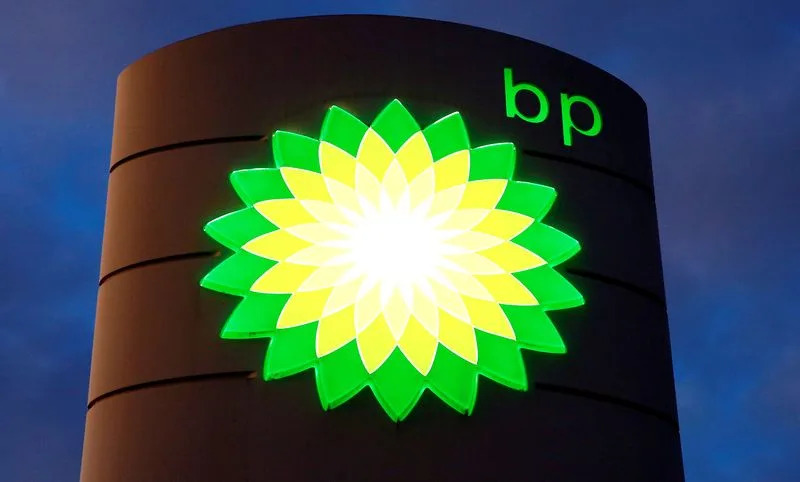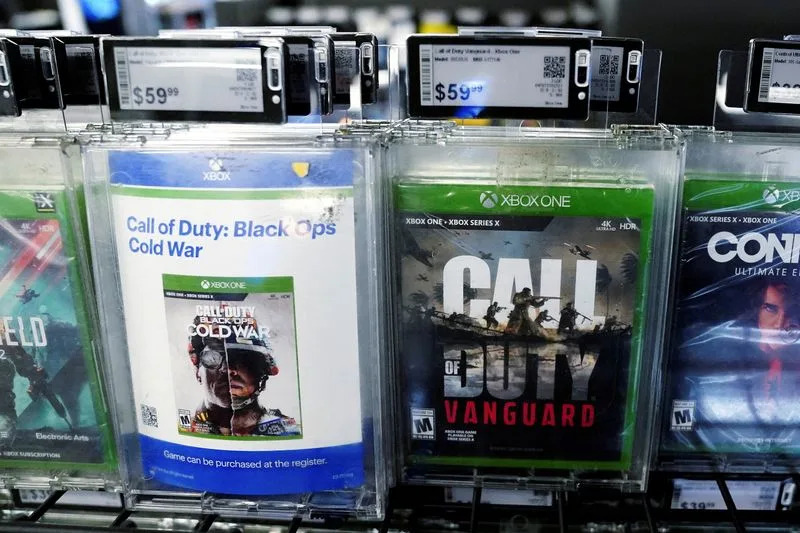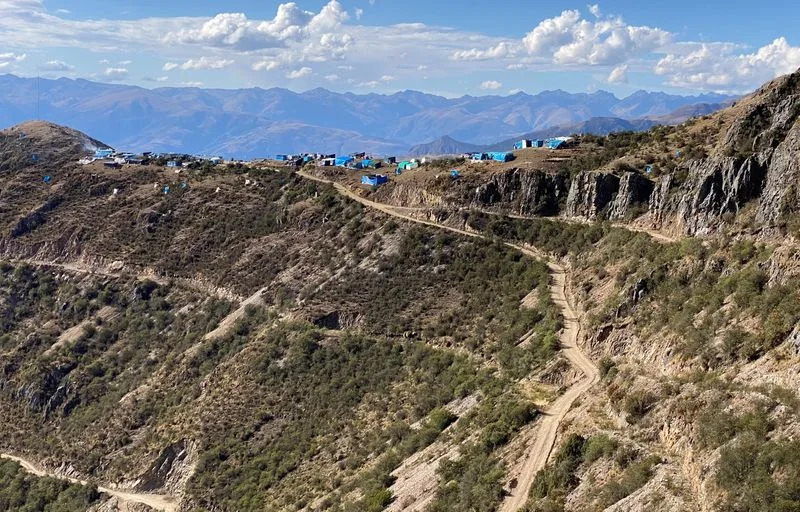BP makes record profit in 2022, slows shift from oil
Ron Bousso and Shadia Nasralla
Tue, 7 February 2023

Logo of BP is seen at a petrol station in Kloten, Switzerland
By Ron Bousso and Shadia Nasralla
LONDON (Reuters) - BP reported on Tuesday a record profit of $28 billion for 2022 and hiked its dividend, but infuriated climate activists by rowing back on plans to slash oil and gas output and reduce carbon emissions by 2030.
The blockbuster profit follows similar reports from rivals Shell, Exxon Mobil and Chevron last week after energy prices surged in the wake of Russia's invasion of Ukraine, prompting new calls to further tax the sector as households struggle to pay energy bills.
Three years after CEO Bernard Looney took the helm with an ambitious plan to pivot BP away from oil and gas towards renewables and low-carbon energy, the company said it will increase annual spending in both sectors by $1 billion with a sharper focus on developing low-carbon biofuels and hydrogen.
But it scaled back plans to cut oil output, now aiming to produce 2 million barrels of oil equivalent per day by 2030, down just 25% from 2019 levels compared with previous plans for a 40% cut.
As a result, BP reduced its ambitions to cut emissions from fuels sold to customers to 20-30% by 2030, from 35-40%. BP still aims to reduce its total emissions to net zero by 2050.
"We need lower carbon energy, but we also need secure energy, and we need affordable energy. And that's what governments and society around the world are asking for," Looney told analysts.
While many investors backed Looney's strategy, which he told Reuters "is working", BP's shares have significantly underperformed top Western energy companies since the CEO took office, remaining largely flat compared with a 17% gain for Shell and a nearly 80% rise in Exxon shares.
"If the bulk of your investments remain tied to fossil fuels, and you even plan to increase those investments, you cannot claim to be aligned" with the 2015 U.N. backed goals to battle climate change, Mark van Baal, founder of activist shareholder group Follow This said.
BP's $4.8 billion fourth-quarter underlying replacement cost profit, its definition of net income, narrowly missed a $5 billion company-provided analyst forecast.
The results were impacted by weaker gas trading activity after an "exceptional" third quarter, higher refinery maintenance and lower oil and gas prices.
But for the year, BP's $27.6 billion profit exceeded its 2008 record of $26 billion despite a $25 billion writedown of its Russian assets.
That allowed it to boost its dividend by 10% to 6.61 cents per share, after halving it in the wake of the pandemic, and announce plans to repurchase $2.75 billion worth of shares over the next three months after buying $11.7 billion in 2022.
BP shares ended 7.6% higher on the day, their best daily performance since November 2020.
Graphic: BP's annual results- https://www.reuters.com/graphics/BP-RESULTS/zdvxoakoepx/chart.png
ENERGY TRANSITION
BP reiterated plans to divide its spending to 2030 equally between the oil and gas business and its energy transition businesses, upping the total budget to up to $18 billion from a previously guided upper range of $16 billion.
Transition businesses, such as renewables and electric vehicle charging, account for around 30% of the current budget compared with 3% in 2019.
BP kept it returns outlook for renewables largely unchanged at 6%-8%, without taking into account debt, even though global offshore wind production costs have soared in recent months.
Looney said BP's wind and solar production will focus more on providing renewable power to generate biofuels and low-carbon hydrogen, focusing particularly in the United States where the landmark Inflation Reduction Act offers investment credits and tax cuts.
BP, whose trading operations further boost renewables returns, maintained plans to have 50 gigawatts (GW) of renewable projects under development and 10 GW operating by 2030.
It said it expects returns of upwards of 15% from its bioenergy business and its combined electric vehicle charging and convenience store businesses, while looking for double-digit returns on hydrogen.
It aims to translate this into a core profit from the transition businesses of $10 billion-$12 billion by 2030, out of targeted total group earnings before interest, tax, depreciation and amortisation (EBITDA) of $51 billion-$56 billion.
BP also wants to increase its focus on renewable natural gas having last year acquired U.S. producer Archaea Energy for $4.1 billion, and it has also set a target to produce 0.5 million-0.7 million tonnes a year of low-carbon hydrogen to initially supply its own refineries.
BP, which increased its 2030 oil price forecast by $10 to $70 a barrel, will focus its global oil and gas operations in nine regions, with plans to sharply increase output from its U.S. shale business and in the Gulf of Mexico.
Graphic: BP's quarterly profits- https://www.reuters.com/graphics/BP-RESULTS/zgpobkjakvd/chart.png
(Reporting by Ron Bousso and Shadia Nasralla; Editing by Kirsten Donovan and Mark Potter)
BP Adds to Big Oil Cash Gusher With Dividend Hike, Buybacks
William Mathis
Tue, 7 February 2023


(Bloomberg) -- BP Plc hiked its dividend and extended share buybacks after posting a record profit of $27.65 billion for 2022, joining its fellow supermajors by reaping the rewards of soaring oil and natural gas prices.
The cash gusher is delivering significant returns to investors — a 10% increase in the dividend and an extra $2.75 billion of buybacks — while also highlighting a contradiction at the heart of Europe’s oil industry. As major producers talk increasingly about the need to cut emissions and switch to cleaner energy, their polluting fossil fuel business is becoming ever more lucrative as a result of Russia’s invasion of Ukraine.
BP pledged to accelerate investments in both low-carbon energy and fossil fuels. However, the company slowed down its plan to get out of oil and gas and will be less aggressive in curbing its carbon emissions.
By 2030, production of fossil fuels will be about 25% lower than it was in 2019, excluding the contribution from Russia’s Rosneft PJSC. That’s a big revision to its 2020 goal to cut output by 40% by the end of the decade.
Shares of the company rose 3.2% to 493.5 pence as of 8:01 a.m. in London.
“We are growing our investment into our transition and, at the same time, growing investment into today’s energy system.” Chief Executive Officer Bernard Looney said in a statement on Tuesday. “It’s what governments and customers are asking of companies like us.”
BP said it would evenly split additional investment between low-carbon energy and oil and gas, spending up to $8 billion more on each by 2030. Annual capital expenditure could be slightly higher than previously planned, ranging between $14 billion and $18 billion each year for the rest of the decade.
The company will target petroleum resources that can be developed quickly, offer a fast payback and overall better returns. Last month, in its Energy Outlook report, BP predicted that Russia’s invasion of Ukraine would accelerate the world’s transition away from fossil fuels as countries seek to boost energy security by generating more renewable energy at home.
BP pledged to deliver higher returns from both clean energy and fossil fuels. By increasing investment and revising oil and gas price assumptions higher, the company said it would grow earnings per share before interest, taxes, depreciation and amortization by 12% a year through to 2025.
BP’s adjusted net income was $4.81 billion in the fourth quarter, down from the record-setting levels reached earlier in the year and missing the average analyst estimate of $5.11 billion.
The profit boom has been healthy for BP’s balance sheet, something that had been a source of investor concern in the years following the 2010 Deepwater Horizon oil spill. Net debt fell for the 11th successive quarter and was down by $9.2 billion over 2022.
--With assistance from Will Kennedy.
William Mathis
Tue, 7 February 2023


(Bloomberg) -- BP Plc hiked its dividend and extended share buybacks after posting a record profit of $27.65 billion for 2022, joining its fellow supermajors by reaping the rewards of soaring oil and natural gas prices.
The cash gusher is delivering significant returns to investors — a 10% increase in the dividend and an extra $2.75 billion of buybacks — while also highlighting a contradiction at the heart of Europe’s oil industry. As major producers talk increasingly about the need to cut emissions and switch to cleaner energy, their polluting fossil fuel business is becoming ever more lucrative as a result of Russia’s invasion of Ukraine.
BP pledged to accelerate investments in both low-carbon energy and fossil fuels. However, the company slowed down its plan to get out of oil and gas and will be less aggressive in curbing its carbon emissions.
By 2030, production of fossil fuels will be about 25% lower than it was in 2019, excluding the contribution from Russia’s Rosneft PJSC. That’s a big revision to its 2020 goal to cut output by 40% by the end of the decade.
Shares of the company rose 3.2% to 493.5 pence as of 8:01 a.m. in London.
“We are growing our investment into our transition and, at the same time, growing investment into today’s energy system.” Chief Executive Officer Bernard Looney said in a statement on Tuesday. “It’s what governments and customers are asking of companies like us.”
BP said it would evenly split additional investment between low-carbon energy and oil and gas, spending up to $8 billion more on each by 2030. Annual capital expenditure could be slightly higher than previously planned, ranging between $14 billion and $18 billion each year for the rest of the decade.
The company will target petroleum resources that can be developed quickly, offer a fast payback and overall better returns. Last month, in its Energy Outlook report, BP predicted that Russia’s invasion of Ukraine would accelerate the world’s transition away from fossil fuels as countries seek to boost energy security by generating more renewable energy at home.
BP pledged to deliver higher returns from both clean energy and fossil fuels. By increasing investment and revising oil and gas price assumptions higher, the company said it would grow earnings per share before interest, taxes, depreciation and amortization by 12% a year through to 2025.
BP’s adjusted net income was $4.81 billion in the fourth quarter, down from the record-setting levels reached earlier in the year and missing the average analyst estimate of $5.11 billion.
The profit boom has been healthy for BP’s balance sheet, something that had been a source of investor concern in the years following the 2010 Deepwater Horizon oil spill. Net debt fell for the 11th successive quarter and was down by $9.2 billion over 2022.
--With assistance from Will Kennedy.














